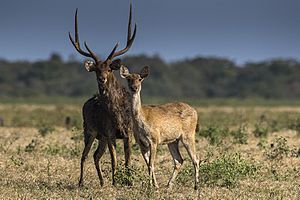Javan rusa facts for kids
Quick facts for kids Javan rusa |
|
|---|---|
 |
|
| Male and Female at Baluran National Park, East Java, Indonesia | |
| Conservation status | |
| Scientific classification | |
 |
|
| Present distribution within the native range, including possible ancient introductions | |
| Synonyms | |
|
List
Cervus celebensis Rorig, 1896 Cervus hippelaphus G.Q. Cuvier, 1825 [preoccupied)] Cervus lepidus Sundevall, 1846 Cervus moluccensis Quoy & Gaimard, 1830 Cervus peronii Cuvier, 1825 Cervus russa Muller & Schlegel, 1845 Cervus tavistocki Lydekker, 1900 Cervus timorensis Blainville, 1822 Cervus timorensis ssp. rusa Muller & Schlegel, 1845 Cervus tunjuc Horsfield, 1830 [nomen nudum] |
The Javan rusa or Sunda sambar (Rusa timorensis) is a type of deer. It naturally lives on the islands of Java, Bali, and Timor. These islands are all part of Indonesia.
This deer has also been moved by humans to many other places. These include Western New Guinea, Borneo, the Lesser Sunda Islands, Maluku, and Sulawesi. You can also find them in Australia, Mauritius, New Caledonia, New Zealand, Papua New Guinea, and Réunion.
Javan rusa deer like to live in open, dry forests. They also live in parklands and savannas. Their homes are similar to where the Chital deer lives in India. The Javan rusa is a close relative of the larger sambar deer. People sometimes hunt them in eastern Australasia. These deer usually breed in July and August. They are most active in the early morning and late afternoon.
Contents
What Javan Rusa Deer Look Like
Rusa deer are easy to spot because of their large ears. They also have tufts of hair above their eyebrows. Males have antlers, which are bony growths on their heads.
Male Javan rusa deer are much bigger than females. Males can weigh between 152 and 160 kilograms (about 335-353 pounds). Females are smaller, weighing around 74 kilograms (about 163 pounds). Unlike many other types of deer, baby Javan rusa fawns do not have spots when they are born.
Where Javan Rusa Deer Live
The Javan rusa deer is originally from the islands of Java, Bali, and Timor. These islands are all found in Indonesia.
Over time, these deer have been brought to many other places. These include Western New Guinea, Borneo (Kalimantan), and the Lesser Sunda Islands. They also live in Maluku, Sulawesi, Pohnpei, and Mauritius. Other places include Fiji, Tonga, Samoa, Vanuatu, and the Solomon Islands. You can also find them on Christmas Islands, the Cocos Islands, and Nauru. They were also introduced to Australia, New Caledonia, New Zealand, Papua New Guinea, New Britain, and New Ireland. For example, rusa deer were brought to New Guinea in the early 1900s.
These deer prefer open areas like dry forests and mixed deciduous forests. They also like parklands and savannas. Sometimes, rusa deer are found on remote islands. They might have been brought there by Indonesian fishermen a long time ago.
How Javan Rusa Deer Live
Javan rusa deer are usually active in the early morning and late afternoon. They almost never come out into open spaces during the middle of the day. It is very hard to get close to them. This is because they have very sharp senses and are naturally cautious.
These deer are rarely found alone. They usually stay in groups. If a male rusa deer gets scared, it will make a very loud honking sound. This sound acts as an alarm call. It warns any other deer nearby that there might be danger.
Like other types of deer, Javan rusa mostly eat grass and leaves. They also enjoy eating fallen fruit. Interestingly, they do not need to drink water. They get all the water they need from the food they eat.
The main animals that hunt Javan rusa deer are the Javan leopard and the dhole. Other predators include crocodiles, pythons, and the Komodo dragon.
Javan Rusa Deer Reproduction and Life Cycle
Javan rusa deer usually breed around July and August. During this time, male deer, called stags, will compete for females. They make loud, shrill barking sounds. They also fight each other using their antlers.
After mating, the female deer, called a doe, will give birth. She usually has one or two calves. The pregnancy, or gestation period, lasts about 8 months. The calves are born at the beginning of spring. Young Javan rusa stop drinking milk and start eating solid food when they are 6 to 8 months old. They become old enough to have their own babies when they are 3 to 5 years old. This depends on where they live. Javan rusa deer can live for 15 to 20 years. This is true whether they live in the wild or in zoos.
Images for kids
-
The Javan rusa is featured on a 1988 Indonesian rupiah banknote
See also
 In Spanish: Sambar de Timor para niños
In Spanish: Sambar de Timor para niños




